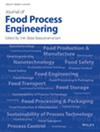Design and Development of Temperature Control System in Microwave-Based Milk Pasteurization Plant With High Temperature Short Time (HTST) Method
Abstract
Raw cow's milk generally has bacterial contamination that comes from the environment and the cow itself. Coliform bacteria are one group of bacteria used as indicators of food product sanitation, including sanitation in milk. Based on SNI 7388 of 2009, the maximum contamination limit for coliform microbes in raw fresh milk is 20 colonies/ml. One way to minimize microbial contamination in raw fresh milk so that the milk does not exceed the maximum contamination limit is by applying pasteurization. In this research, a prototype of milk pasteurization plant with a temperature control system utilizing microwaves is successfully made. The milk pasteurization plant will be made by modifying the microwave as a dielectric heater. The pasteurization method to be used in this milk pasteurization plant is HTST (High Temperature Short Time) by heating milk at 72°C for 15 s. The suggested power variation is the high power with 450 watt which has a rise time value of 421 s (7 min) and a settling time of 527 s (8.78 min), which is the shortest value compared to other variations. Microwave-based milk pasteurization plant with HTST method equipped with temperature control system and LabVIEW-based HMI is able to eliminate coliform contamination contained in raw cow's milk so that the milk is safe for consumption.


 求助内容:
求助内容: 应助结果提醒方式:
应助结果提醒方式:


